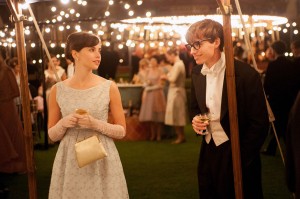The Theory of Everything stirs with a powerful story
Take one look at The Theory of Everything trailer, and it’s difficult not to tear up. After all, it appears to be a remarkable story that will undoubtedly pull at every heartstring, anguish and frailty inside the human body. It’s the common cliché story of love conquering all — even physicist Stephen Hawking’s dreadful motor neuron disease.

Firsthand account · The story is adapted from Traveling to Infinity, the autobiography of Stephen Hawking’s first wife Jane, played in the film by Felicity Jones. This point of view offers a unique perspective into the immense strain that the onset of ALS in Hawking caused on their relationship. – Photo courtesy of Focus Features Media
Directed by James Marsh, the biopic, which was adapted from Jane Hawking’s autobiography Traveling to Infinity, tells the story of Hawking and his first wife Jane (played by Felicity Jones) first meeting in 1963 and instantly falling in love. Though The Theory of Everything is an entertaining and entrancing film, it does not appear to be the inspiring and cliché love story the trailer claims it to be — rather, it is the struggle of one man to surpass his two years of predicted survival and the sort of short-lived love affair that ultimately dies out as the disease progresses.
The film begins with Hawking (Eddie Redmayne) as a graduate student studying cosmology at Cambridge University, struggling to develop a thesis. At a party, he meets the lovely Jane, a churchgoer studying the arts — the opposite of his science-driven self. As they begin their adorable and awkward relationship, Hawking begins showing early signs of his motor-neuron disease. It continuously progresses until he suffers an awful fall that lands him in the hospital. At the hospital, a doctor frankly tells him that he has motor neuron disease and predicts Hawking has two years left to live.
Despite Hawking’s attempt to hide away, Jane comes to the rescue. Determined to fight the disease, she marries Hawking, and continues what seems the “greatest love affair of all time.” Despite Jane’s initial determination and passion, however, Hawking becomes a chore to her, and the “passionate love” goes missing along with Jane’s burning tenacity. The love and passion die even before the actual disease begins to cause struggles in the relationship. Nevertheless, the couple bizarrely continues having children — despite the lack of any appearance of intimacy between them.
Moreover, in spite of how tired Jane is, she never breaks down emotionally, never loses her cool and never really panics about the circumstances — which makes her character feel unreal in the ease with which she handles the situation. At one point, Jane does reach out to her mother, but the support she receives is the simple suggestion that Jane join the church choir (advice which Jane takes). It almost feels as though Jane’s struggles are reduced to simple stress and annoyance.
Though Jane’s emotions are subdued, the struggles of Hawking are portrayed with astonishing range. Redmayne, who up until this point had played secondary roles in My Week with Marilyn and Les Miserables, proves himself as the true and utter star of the film. Not only can he successfully act, but he also literally embodies Hawking — both the nerdy and awkward physicist and the disease-stricken and physically impaired survivor. Physically, he perfectly shows the bodily changes the disease cause to Hawking’s character, including the slurred speaking, jutting out chin, and hunched over shoulders.
Redmayne also displays the internal struggles that Hawking faced, while the disease took over his body. In one powerful scene, Hawking tries to climb the stairs, but when he can’t, he is stuck making eye contact with his baby son. The son looks down upon Hawking, who at his lowest point cannot do anything to help himself.
Though Hawking’s relationship with Jane fades quickly, his relationships with others are what help carry the film. His friends at Cambridge provide male companions who care for Hawking, and literally carry him where he needs to go. They also provide comedy on multiple occasions — including when his friend places Hawking in the lap of a large statue momentarily while he moves Hawking’s wheelchair up steps. Hawking’s relationship with his eventual red-head bombshell caretaker also brings light to the story, revealing Hawking’s great sense of humor, even during the darkest times of his journey.
The Theory of Everything is an inspirational and heartfelt story, but not for the same reasons the trailer makes it out to seem. Though Jane’s love and determination initially drives the story, it is Hawking’s brilliance and light-heartedness that allows him to overcome his disease. It’s not the traditional love story, but it is a sort of charming and unique conclusion. The relationship ends, but the camaraderie between a once-young and passionate couple lasts. The story breaks the usual cliché that the couple must end up together for a happily ever after ending. In reality though, perhaps there is a different kind of ending to life — an ending that is perfect in its imperfection.

